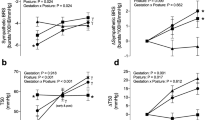Summary
This study was designed to test two hypotheses. First, that the changes in arterial blood pressure, induced by a transition from a lying to a standing position, are different in early and late pregnancy. Second, that birthweight is related to the change in mean arterial blood pressure in late pregnancy such that those patients whose pressure fell on standing should have the lightest babies. Fifty-three patients were studied between the 12th to 18th week, and 41 women were between the 34th to 40th week of an accurately dated, clinically normal, singleton pregnancy. Twelve nulliparous females served as controls. Blood pressure and heart rate were measured at rest, then in the standing position and finally at rest again with a Dinamap blood pressure measuring device. The variability in the pressor response to standing was approximately three times and in heart rate response two times greater in early pregnancy and in late pregnancy, when compared to the nonpregnant controls. It should be further noted that only in late pregnancy did the heart rate fall in 10 out of 41 women on standing. A linear relationship was observed in late pregnancy between the change in mean arterial blood pressure and birthweight (r=0.57,P<0.001). This linear relationship was improved tor=0.86, when only those women (16/41), who either had a rise or fall in systolic blood pressure of more than 5 mm Hg were included. These data indicate that pregnancy increases the variability in the pressor response to standing. Moreover, birthweight was directly related to the magnitude and direction of the pressor response in late pregnancy. Finally, this relationship suggests an additional cause for unexplained cases of intrauterine growth retardation.
Similar content being viewed by others
References
Altmann DG, Coles EC (1980) Nomograms for precise determination of birthweight for dates. Br J Obstet Gynaecol 87:81–86
Barron WM, Mujais SK, Zinaman M, Bravo EL, Lindheimer MD (1986) Plasma catecholamine responses to physiologic stimuli in normal human pregnancy. Am J Obstet Gynecol 154:80–84
Borow KM, Newburger JW (1982) Noninvasive estimation of central aortic pressure using the oscillometric method for analyzing systemic artery pulsatile blood flow: comparative study of indirect systolic, diastolic, and mean brachial artery pressure with simultaneous direct ascending aortic pressure measurements. Am Heart J 103:879–886
Briend A (1980) Maternal physical activity, birth weight and perinatal mortality. Medical Hypotheses 6:1157–1170
Burton AC (1965) Physiology and biophysics of the circulation. Year Book Medical Publishers, Chicago
Clapp JF (1985) Maternal heart rate in pregnancy. Am J Obstet Gynecol 152:659–660
Clapp JF, Seaward BL, Sleamaker RH, Hiser J (1988) Maternal physiologic adaptations to early human pregnancy. Am J Obstet Gynecol 159:1456–1460
Clapp JF (1989) Physiological adaptation in fetal growth retardation. In: Spencer JAD (ed) Fetal monitoring. Castle House Publications, Tunbridge Wells
Gauer OH, Thron HL (1965) Postural changes in the circulation. In: Handbook of physiology, 3rd edn. Circulation. American Physiology Society, Bethesda Maryland, pp 2409–2439
Greiss FC (1982) Uterine pressure flow relationships. In: Moawad AH, Lindheimer MD (eds) Uterine and placental blood flow. Masson Publishing
Hytten F, Chamberlain G (1980) Clinical physiology in obstetrics. Blackwell Scientific Publications, Oxford
Jarmatz H, de Marées G, Kunitsch G (1976) Zur Normierung der orthostatischen Belastung. Vergleich einer normierten statischen Belastung unter Labor-und Routinebedingungen. Med Welt 38:1789
Jeffrey RL, Watson AB, Delaney JJ (1974) Role of bed rest in twin gestation. Obstetrics and Gynecology 43:822–826
Künzel W (1981) Hypotone Blutdruckstörungen als Ursache von Komplikationen in der Geburtshilfe. Z Geburtsh u Perinat 185:249–253
Letourneur L (1897) De l’influence de la profession de la mere sur le poids de l’enfant. Med. Dissertation, University of Paris
MacGillivray I, Rose GA, Rowe B (1969) Blood pressure survey in pregnancy. Clinical Science 37:395–407
de Marées H, Jarmatz H (1967) Zur Normierung der orthostatischen Belastung. Verhalten von versacktem Blutvolumen, arteriellem Einstrom und Herzfrequenz bei verschiedenen orthostatischen Belastungen. Med Welt 38:1784
Master AM, Garfield CI, Walters MB (1952) Normal blood pressure and hypertension. Lea & Febiger, Philadelphia
Metcalfe J, Stock MK, Barron DH (1988) Maternal physiology during pregnancy. In: Knobil E, Neill J (eds) The physiology of reproduction. Raven Press, New York
Morris N, Osborn SB, Wright HP, Hart A (1956) Effective uterine blood flow during exercise in normal and pre-eclamptic pregnancies. Lancet II:481
Naye RL, Peters EC (1982) Working during pregnancy: effects of the fetus. Pediatrics 69:724–727
Nissel H, Hjemdahl P, Linde B, Lunell NO (1985) Sympathoadrenal and cardiovascular reactivity in pregnancy-induced hypertension. II. responses to tilting. Am J Obstet Gynecol 152:554–560
Peller S (1917) Längengewichtsverhältnis der Neugeborenen und Einfluß der Schwangerenernährung auf die Entwicklung des Fötus. Dtsch Med Wochenschr 43:847–848
Phippard AF, Horvath JS, Glynn EM, Garner MG, Fetcher PJ, Duggin GG, Tiller DJ (1986) Circulatory adaptation to pregnancy — serial studies of haemodynamics, blood volume, renin and aldosterone in the baboon (papio hamadryas). J Hypertens 4:773–779
Pinard A (1985) Note pour servir a l’histoire de la puericulture intrauterine. Annales de Gynecologie et d’Obstetrique 44:417–422
Pyörälä T (1966) Cardiovascular response to the upright position during pregnancy. Acta Obstet Gynec Scand 45:1–116
Siddiqi TA, Woods JR, Miodovnik M, et al. (1989) Intrauterine growth retardation: can it be reversed? (Abstract). In: Proceedings of the 36th Annual Meeting of the Society for Gynecologic Investigation, San Diego, 104:132
Suonio S, Simpanen AL, Olkkonen H, Haring P (1976) Effect of the left lateral recumbent position compared with the supine and upright positions on placental blood flow in normal late pregnancy. Ann Clin Res 8:22–26
Thomson AM, Billewicz WZ, Hytten FE (1968) The assessment of fetal growth. J Obstet Gynaecol Br Commonw 75:903–916
Thulesius O (1974) Die Diagnose der orthostatischen Hypotonie anhand einfacher Kreislaufparameter. In: Dengler H (ed) Das Orthostasesyndrom. Schattauer, Stuttgart
Witzleb E (1983) Functions of the vascular system. In: Schmidt RF, Thews G (eds) Human Physiology. Springer, Berlin Heidelberg New York
Author information
Authors and Affiliations
Rights and permissions
About this article
Cite this article
Hohmann, M., Künzel, W. Orthostatic hypotension and birthweight. Arch Gynecol Obstet 248, 181–189 (1991). https://doi.org/10.1007/BF02390357
Received:
Accepted:
Issue Date:
DOI: https://doi.org/10.1007/BF02390357




